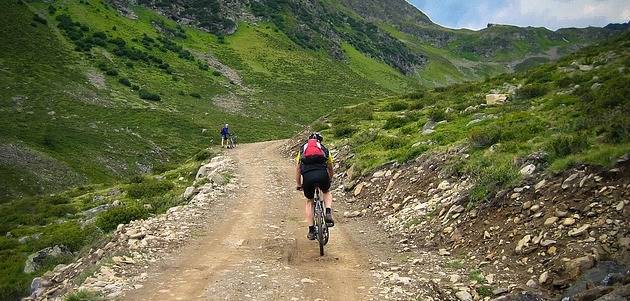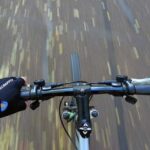Cycling is known to strengthen your calves and help with fat loss. On the one hand, the fat loss makes your calves and legs leaner. Working your calves build muscles and help them grow bigger.
While everyone who rides wants stronger feet; people feel confused as to what extent cycling makes your calves bigger and how?
As a spoiler alert, I must mention cycling alone does not lead to bigger calves; as for most average riders, it will first burn fat and later tone your muscles.
This then results in healthy you with a better posture and overall shape. But you can develop such big hulk sized calves doing cycling if you want.
While this might be a great thing for a few men it’s equally weird for others especially women. Many a time it is these myths that keep some women off bikes.
In this article, we will not just burst some of these myths; but also tell what it takes to makes them come true. Thus explaining how an average rider should not worry while a passionate guy; can finally know how to live up to his dream of hulk-like strong feet and calves.
- Bursting Common Myth’s Related To Cycling
- What Does Biking Do To Our Body?
- 7 Key Points That Helps Avoid Getting Bigger Calves
- 1 ) Stretch Your Body After Each Biking Session
- 2 ) Do Not Use Bikes With Too High Gear Ratio
- 3 ) Mix Biking With Jogging or Brisk Walk
- 4 ) Do Not Perform Additional Resistance Training
- 5 ) Avoid Long Sprints or Hilly Slopes ( Regularly )
- 6 ) Take Diet Based On Your Body Type
- 7 ) Do It Enough To Reduce Calves Not To Built
Bursting Common Myth’s Related To Cycling
First thing first: I believe strong legs are great and something to be proud of irrespective of their gender. After all, in this age of gender-neutral norms and women empowerment; it should be taken as a source of pride and not shame or stigma.
That being said I can also not say everyone should work to get that shape. After all, it’s not easy to achieve and does more harm than good; in terms of motivating others to cycle.
When comes to cycling there are three main myths linked to body image issues; that hinders one especially young girls and women from cycling. These myths are; “cycling makes thighs bigger”, “Will cycling make my legs big?” and “does cycling really makes me skinny?”.
The short answer is: You are not going to develop bigger thighs or legs just by cycling. Being an aerobic exercise it makes your muscles resistant to fatigue, but without adding significant mass.
In general, it takes a lot more than just cycling to get that killer hamstring or bigger calves. You need to participate in different strength training programs in addition to cycling.
While cycling does not build mass or develops new calves muscles; it does add strength to its building high endurance. In addition, it burns fat making your legs look toned and slim.
For women, the risk for developing these massive quads is even less; even when going through vigorous bike exercise with all the strength training. Thanks to their evaluatory advantage of having 15% less testosterone and 10% more body fat.

What Does Biking Do To Our Body?
Biking is considered an aerobic exercise with a high-intensity interval training style. Being aerobic in nature it makes your heart and lungs do the extra workout.
You will experience an increase in body temperature, sweating, and fast deeper breath. This helps improve cardiovascular fitness and reduce mass.
Biking regularly also helps reduce stress, improve strength and build stamina. It is also known for posture control, fat loss, improving joint mobility and overall flexibility.
I personally find it great for improving coordination between different body parts. You can understand this by this example: almost everyone who rides a bike starts with this feeling “it’s hard to balance”.
But as the coordination between his or her legs, hands, eyes, and brain improve overtime it need not take a second thought balancing his or her own body weight while riding.
When riding the muscle group that feels most of the heat is the guards. The muscles group that runs in front of your thighs connecting hip with your knee.
The best way to burn fat cycling is to do it in small high-intensity bursts of 20 to 30 minutes. Followed by a little stretching or resistance training ( only if you want those muscular guards ).
7 Key Points That Helps Avoid Getting Bigger Calves
When embracing biking as your go-to fitness workout; what you get is a stronger leg ( without adding significant muscle mass ), flexible body, higher strength, and better stamina.
While it is highly unlikely you can develop strong legs with bulky calves; under normal workout conditions of 30 to 60 minutes of biking. But there is always some room available for it to happen.
So when you want to pursue it especially being a woman; you do not want to have any risk factor that can change your female body. So here are 7 tips to help you avoid getting bigger calves:
1 ) Stretch Your Body After Each Biking Session
Flexibility is key to faster bike sprints or aggressive cycling. But biking makes our lower body to work excessively.
Cranking out the miles on a road works out all major leg muscles. Now, since it been a part of high-intensity interval training; it burns calories and fat but makes your muscles stiff and fatigue.
If not been taken care of our body have this mechanism of fight or flight response. In this, if possible your targeted muscles will grow to fit the growing demand; or will simply break down with pain and injury.
So its always advised doing perform post biking stretching. Since it affects mostly the calves, glutes, and Maximus choose stretching techniques that help them all.
This can include methods such as; Quad Stretch, Doorway Stretch, and Standing Hamstring Stretch to name a few.
2 ) Do Not Use Bikes With Too High Gear Ratio
You heard it just right if you want to keep your calves thin; do not take bikes with higher gear ratio for longer rides.
To ride a bike for long is itself physically demanding. Now to do it with one of the higher gear ratios ask you to put extra effort with your calves and lower leg; letting them no choice but to grow or breakdown.
The only good thing is you will not develop such a thing; from your first ride on a high gear ratio bike.
So if you are women who pay attention to the minute details of self-body; there might be still time to switch to a gearless bike or bike with a lower gear ratio. In the end, it is all about the choices we made.
Even when you are not concerned about your calves; it’s always not wise to jump for the bike with the highest gear ratio. Without trying different setups, how can you find an idle combination for the body?
3 ) Mix Biking With Jogging or Brisk Walk
While both cycling and jogging are considered aerobic exercise; they are certainly of different types. Asking for jogging or a brisk walk on top of cycling can be too much for a few.
But remember it is this mixing of your exercises that eventually helps in the long run.
From outside ridding a bike offers the same benefits as running in terms of the cardiovascular system. From inside cycling isolates your body into two parts; active lower body and other body parts.
So while in cycling your efforts are concentrated just in lower body; running is a full-body exercise involving all muscle groups.
Thus while you need to put more effort into running; you will never gain muscles but rather maintain them or even loose a little sometimes. So whether you like it or not; add a brisk walk or jogging in your training routine.
4 ) Do Not Perform Additional Resistance Training
aah, my favorite. This is the one you should be doing after biking to add strong muscles in your calves.
During resistance training, your body burns additional calories but in a controlled way. This boosts growth hormone thus laying the groundwork for building newer strong muscles.
When combined with higher testosterone levels and suitable body type; it results in quicker but better results.
So unless you want a hulk size calves that really helps you with leg strength; working in your advantage in major biking competition. It is wise to stay out or not do it regularly to have a significant impact.
Cyclists who focus on long rides especially on mountains can benefit from those big legs. So go out for those strong legs if you really wanted to.

5 ) Avoid Long Sprints or Hilly Slopes ( Regularly )
Have you seen it is quite hard on your legs when riding on hilly terrains or following a long sprint? No matter how you do, you always face the heat. If done regularly it can slowly but surely build stronger muscles in your leg.
That is why it is always said something new and better emerges mostly under load and stress.
Otherwise, why would sprinters who have developed or under developing tree-trunk quads; routinely hammer lots of gears on hilly terrains.
Even institutes like NSCA ( National Strength and Conditioning Association ) states; To increase muscle hypertrophy you need to work with heavier loads and challenging conditions.
Ridding on hills will gradually make your legs stronger followed by the development of newer muscles. Something you shouldn’t do regularly if you love those slimmer legs.
6 ) Take Diet Based On Your Body Type
Our body can be classified into three main types based on how it reacts to hormones, food, and exercise. These are endomorphs, mesomorphs, and ectomorphs.
You must have seen two or more people on the same diet; following the same type of exercise show different results. This is simply one of the effects of having a particular body type.
Overall, It plays a huge role in determining results for a particular exercise. Endomorphs are people with a slower metabolism. They are genetically at a disadvantage for fat loss or building muscles.
These people grow little to no muscles and do not lose their body fat easily. They must follow resistance training followed by cycling. These people do not develop bigger calves even with intense exercise.
On another hand, mesomorphs can both gain and lose fat by undergoing certain dietary changes followed by exercise. These are the people who are at most risk of developing bigger calves.
Ectomorphs are these tall lean fellow with higher metabolism rates. These people do not hold on fat in their bodies for long. They are generally at low risk as it takes too long for them to build that size.
7 ) Do It Enough To Reduce Calves Not To Built
You must have heard that proverb “Everything is good but within limits”. Whether it’s cycling for fun, weight loss, resistance training or more it will have a positive impact on your body unless you overdo.
Plus even when you are developing newer muscles; it’s much leaner than fat and consume much more energy to sustain.
This means developing new muscles in a small amount is good for you. Now your muscles do the work for burning calories in higher numbers. So you not just look lean but also have sufficient strength.
General Disclaimer: This article is for general information only and does not intended to replace an informed medical opinion. You should not use this information to diagnose or treat a health problem. Always consult your doctor before changing your diet, sleep habits, dietary supplements, or a new exercise routine.
Also Read,
Regular Cycling: 9 Reasons Cycling Is Good for Your Mental Health









Keep at it. A great form of exercise.
Thank you! I completely agree—cycling is such a fantastic way to stay active and enjoy the outdoors. Appreciate the encouragement!